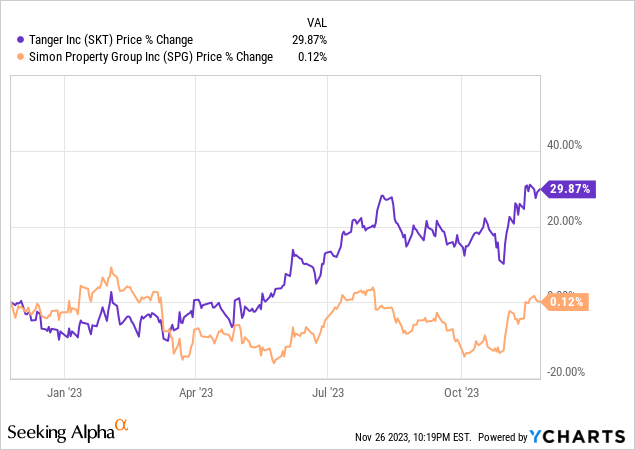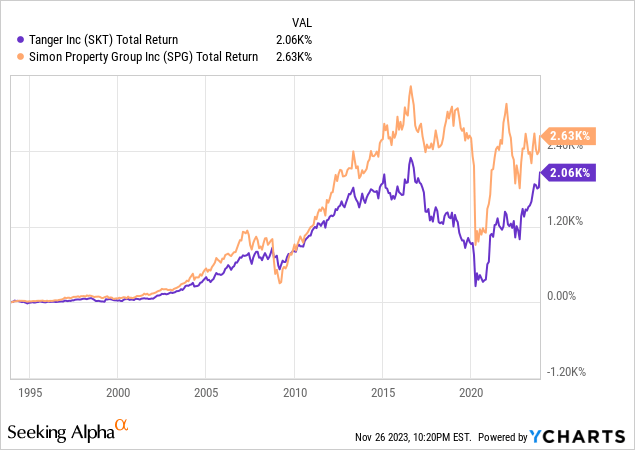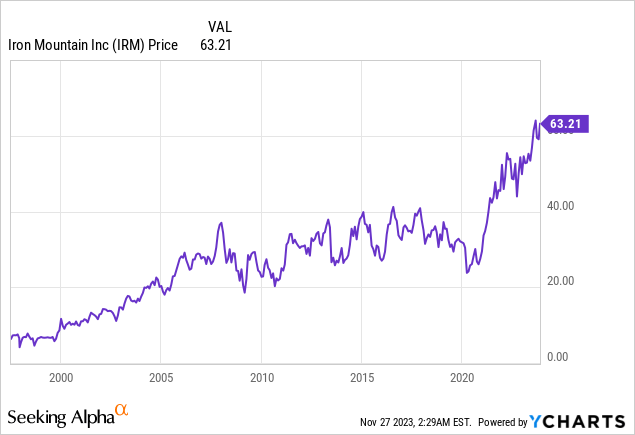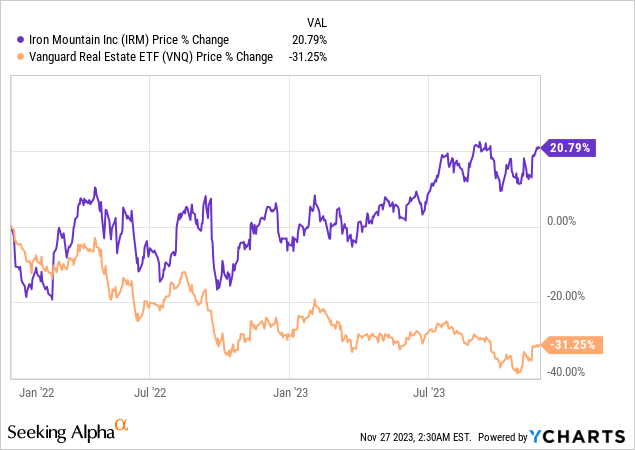In recent weeks, I have written many articles stating that REITs (VNQ) are today priced at their lowest valuations in over 10 years.
Their share prices have crashed even as their rents kept on rising and as a result, many REITs are now priced at just 50 cents on the dollar. Here are just a few examples (ARE; CCI; NXRT):

But that does not mean that all REITs are cheap.
The REIT world is vast and there is still a minority of them that remain priced at aggressive valuations, at least relative to their close peers.
In today’s article, we will discuss two such cases. Before I get into it, let me be transparent about the fact that I have been wrong about these two REITs in the past. I have made bearish calls on them, and my timing has been off. They have still kept outperforming the REIT sector averages, and as a result, their valuations have only grown larger. I believe that this recent outperformance is unwarranted and their premium valuations aren’t justified. Here’s why:
Tanger (SKT)
Overall, Tanger is a good REIT.
They have a good balance sheet, a shareholder-friendly management team, and pretty decent assets.
But here’s the issue: it has massively outperformed its close peer, Simon Property Group (SPG) over the recent past and it now trades at a materially higher valuation:

| SKT | SPG | |
| FFO Multiple | 13x | 10x |
| Dividend Yield | 4% | 6.3% |
This recent outperformance and higher valuation may leave you thinking that SKT is a better REIT than SPG, but in reality, it is the opposite. SPG has a better balance sheet… superior assets… and a stronger track record:

The main difference is in the assets. SKT focuses mostly on outlet centers whereas SPG focuses mainly on class A malls.
This may not seem like a big difference, but as a real estate investor, I would much rather own Class A malls than outlet centers.
That’s because Class A malls are generally in highly desirable locations that enjoy high population density, population growth and limited new supply. Moreover, Class A malls are diversified in their uses with big service, entertainment, and non-retail components that drive steady traffic that’s not impacted by the growth of e-commerce. They also attract luxury brands like Louis Vuitton (OTCPK:LVMHF), Tesla (TSLA), and Apple (AAPL), etc. that use malls for many purposes: showrooms, last-mile delivery, service centers, return centers, etc… Finally, the real estate of Class A malls is generally quite flexible, meaning that it can be adapted to different uses, including non-retail, and it can be densified. So overall, high-end malls are great real estate…
Simon Property Group
Outlet centers are the opposite.
They are generally in more remote locations where land is cheap and abundant. The barriers to entry are far smaller and there’s a greater risk of being impacted by new competition. This is especially true today given the rapid growth of e-commerce and discount retailers like TJ Maxx (TJX). Outlets only compete on prices so that’s a big problem in today’s day and age. Suddenly, the 30-minute drive to go to an outlet center feels a lot longer because you could order the same stuff on Amazon (AMZN) or head to a more conveniently located TJ Maxx instead.
Moreover, outlets focus mainly on fashion and accessories, which are especially heavily impacted by the growth of e-commerce, and their layouts are not nearly as flexible.
Therefore, I would expect class-A malls to do far better than outlet centers over the long run. That does not mean that outlets will do poorly, but I sure wouldn’t pay a premium to own outlets when I could buy Class A malls at a discount.
Yet, that’s what investors are doing by buying SKT instead of SPG.
I believe that its risk-to-reward is relatively poor when compared to SPG and for this reason, I have no interest in owning SKT at this time.
Iron Mountain (IRM)
Iron Mountain is an even more extreme example.
It is one of just a few REITs that’s today pushing new all-time highs:

That’s despite the historic surge in interest rates.
It is truly exceptional that its valuation multiple has expanded by this much even as interest rates rose to new highs.
The outperformance relative to the broader REIT market is massive and I surely didn’t see it coming:

I think that at least part of this outperformance is due to the recent AI craze.
IRM owns some data centers so it is getting some of that hype.
As a result, it now trades at 22x FFO and a 4% dividend yield, a historically high multiple for the company. I remember pitching it when it traded at just 10x FFO and offered an 8% dividend yield and that wasn’t so long ago!
Seeking Alpha
And here’s why this high valuation is very concerning: IRM actually isn’t a data center REIT. It is a paper storage REIT. It earns most of its revenue from paper storage, which clearly isn’t a growth industry, and it is now expanding into data centers, but this remains a minor part of its business.
Iron Mountain
Even more concerning for me as a real estate investor is the fact that quite often, IRM does not even own its real estate. Instead, it owns just the racks inside its paper storage facilities and the properties are leased on a long-term basis. This means that you won’t enjoy the same benefits of long-term property appreciation. It warrants a lower valuation multiple, but the market has now priced IRM at a steep premium relative to the broader REIT market:
| IRM | Average REIT Sector | |
| FFO Multiple | 21x | 14x |
Today, the focus is on the AI revolution.
But a few years from now, the narrative could have changed again, and if the focus returns to its paper storage business, then its valuation multiple could come crashing down.
It simply does not deserve its current valuation multiple, especially in today’s higher interest rate environment.
Bottom Line
I am so bullish on REITs that I invest about 50% of my net worth in them.
Their valuations are the lowest since the great financial crisis and I think that this is a historic opportunity to win big in the coming years.
But this is a vast world and it is very important to be selective.
Editor’s Note: This article discusses one or more securities that do not trade on a major U.S. exchange. Please be aware of the risks associated with these stocks.
Read the full article here



